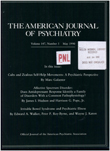A multidimensional approach to the genetics of schizophrenia
Abstract
To determine which dimensions of psychopathology are associated with a greater liability to develop schizophrenia, the authors examined the case histories of 151 monozygotic probands from five twin studies. Proband twins from pairs concordant for schizophrenia had greater numbers of negative symptoms, poorer premorbid adjustment, fewer paranoid symptoms, and earlier ages at onset than probands from discordant pairs. In discriminant analyses, negative symptoms, premorbid social competence, and paranoid symptoms each contributed to the discrimination between concordant and discordant pairs. These results provide support for Strauss et al.'s suggestion that these three types of symptoms reflect three different functional processes in the development of schizophrenia.
Access content
To read the fulltext, please use one of the options below to sign in or purchase access.- Personal login
- Institutional Login
- Sign in via OpenAthens
- Register for access
-
Please login/register if you wish to pair your device and check access availability.
Not a subscriber?
PsychiatryOnline subscription options offer access to the DSM-5 library, books, journals, CME, and patient resources. This all-in-one virtual library provides psychiatrists and mental health professionals with key resources for diagnosis, treatment, research, and professional development.
Need more help? PsychiatryOnline Customer Service may be reached by emailing [email protected] or by calling 800-368-5777 (in the U.S.) or 703-907-7322 (outside the U.S.).



